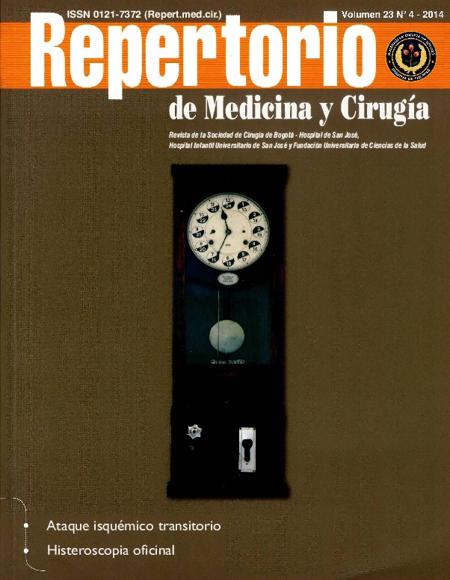Ataque isquémico transitorio: Incidencia de accidente cerebrovascular fatal: Seguimiento a seis meses
Transient ischemic attack: Fatal stroke incidence: Six-month follow-up
Cómo citar
Descargar cita
Esta obra está bajo una licencia internacional Creative Commons Atribución-NoComercial-CompartirIgual 4.0.
Mostrar biografía de los autores
El AIT (ataque isquémico transitorio) se considera predictor de ACV. El seguimiento a seis meses mostró un riesgo cercano al 10%. Son dos espectros de la enfermedad cerebro vascular isquémica de alto impacto en la morbi-mortalidad a nivel mundial. Objetivo: evaluar la incidencia de ACV en pacientes con AIT hospitalizados en dos instituciones con seguimiento a 180 días. Metodología: estudio de cohorte, el AIT se definió por historia y examen clínico, excluyendo el infarto por neuroimagen. Se evaluó el riesgo de ACV con la escala ABCD2, documentándolo por neuroimagen. Resultados: ingresaron 85 casos (abril 2012/ abril 2013). Edad promedio 68.1 años (DE 13.5), 62.4% mujeres. Los factores de riesgo más frecuentes fueron HTA (69.4%), dislipidemia (56.4%), tabaquismo (31.1%) y antecedente de ACV (18.8%). El 24.6% presentó ACV (n:19), con dos fallecimientos (2.4%). El ABCD2 ≥ 5 fue predictor de ACV, HR 4.7 [IC 95% 1.1-20.7]. Entre los pacientes con previo antecedente de ACV, la mitad de ellos repitió el evento (8/16), HR 2.2 [IC 95% 0.81-6.1]. Conclusión: hay alta incidencia de ACV después de AIT. Se requieren estudios con muestra de mayor tamaño. Abreviaturas: AIT, ataque isquémico transitorio; ACV, accidente cerebrovascular; HTA, hipertensión arterial.
Visitas del artículo 1267 | Visitas PDF 3364
Descargas
1. Dennis M, Bamford J, Sandercock P, Warlow C. Prognosis of transient ischemic attacks in the Oxfordshire Community Stroke Project. Stroke. 1990; 21(6):848-53.
2. Ovbiagele B, Kidwell CS, Saver JL. Epidemiological impact in the United States of a tissue-based definition of transient ischemic attack. Stroke. 2003; 34(4):919-24.
3. Easton JD, Saver JL, Albers GW, Alberts MJ, Chaturvedi S, Feldmann E, et al. Definition and evaluation of transient ischemic attack: a scientific statement for healthcare professionals from the American Heart Association/American Stroke Association Stroke Council; Council on Cardiovascular Surgery and Anesthesia; Council on Cardiovascular Radiology and Intervention; Council on Cardiovascular Nursing; and the Interdisciplinary Council on Peripheral Vascular Disease. The American Academy of Neurology affirms the value of this statement as an educational tool for neurologists. Stroke. 2009; 40(6):2276-93.
4. Colombia. Ministerio de Salud y Protección Social. Indicadores básicos de salud, situación de salud en Colombia [monografía en Internet]. Bogotá: El Ministerio; 2013. [Citado 30 Sep. 2014]. Disponible en: http://www.minsalud.gov.co/salud/paginas/indicadoresbasicossp.aspx
5. Weimar C, Benemann J, Michalski D, Müller M, Luckner K, Katsarava Z, et al. Prediction of recurrent stroke and vascular death in patients with transient ischemic attack or nondisabling stroke: a prospective comparison of validated prognostic scores. Stroke. 2010; 41(3):487-93.
6. Luengo-Fernandez R, Paul NL, Gray AM, Pendlebury ST, Bull LM, Welch SJ, et al. Population-based study of disability and institutionalization after transient ischemic attack and stroke: 10-year results of the Oxford Vascular Study. Stroke. 2013; 44(10):2854-61.
7. Banks JL, Marotta CA. Outcomes validity and reliability of the modified Rankin scale: implications for stroke clinical trials: a literature review and synthesis. Stroke. 2007; 38(3):1091-6.
8. Johnston SC, Rothwell PM, Nguyen-Huynh MN, Giles MF, Elkins JS, Bernstein AL, et al. Validation and refinement of scores to predict very early stroke risk after transient ischaemic attack. Lancet. 2007; 369(9558):283-92.
9. Grant EG, Benson CB, Moneta GL, Alexandrov AV, Baker JD, Bluth EI, et al. Carotid artery stenosis: grayscale and Doppler ultrasound diagnosis--Society of Radiologists in Ultrasound consensus conference. Ultrasound Q. 2003; 19(4):190-8.
10. Purroy F, Jiménez Caballero PE, Gorospe A, Torres MJ, Alvarez-Sabin J, Santamarina E, et al. Prediction of early stroke recurrence in transient ischemic attack patients from the PROMAPA study: a comparison of prognostic risk scores. Cerebrovasc Dis. 2012; 33(2):182-9.
11. Amarenco P, Labreuche J, Lavallée PC. Patients with transient ischemic attack with ABCD2 <4 can have similar 90-day stroke risk as patients with transient ischemic attack with ABCD2 ≥4. Stroke. 2012; 43(3):863-5.
12. Chandratheva A, Geraghty OC, Luengo-Fernandez R, Rothwell PM, Study OV. ABCD2 score predicts severity rather than risk of early recurrent events after transient ischemic attack. Stroke. 2010; 41(5):851-6.
13. Chandratheva A, Lasserson DS, Geraghty OC, Rothwell PM, Study OV. Population-based study of behavior immediately after transient ischemic attack and minor stroke in 1000 consecutive patients: lessons for public education. Stroke. 2010; 41(6):1108-14.













